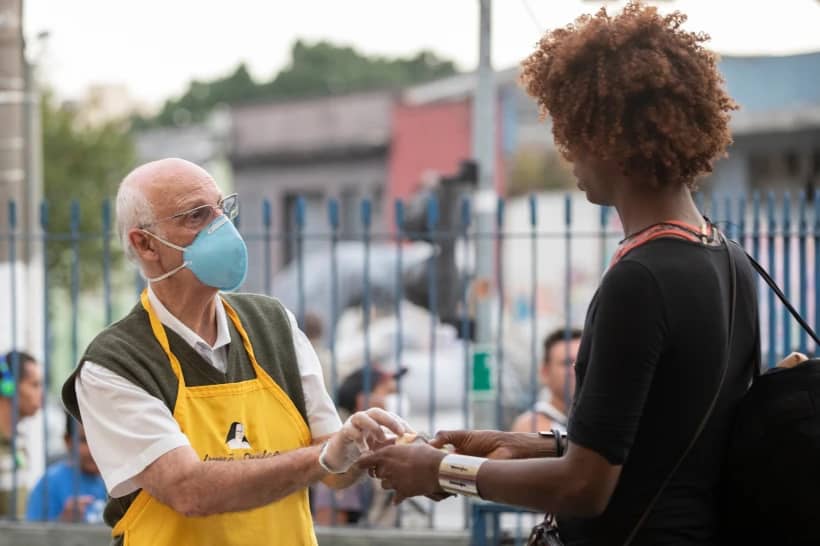SÃO PAULO – Brazilian-born Monsignor João Scognamiglio Clá Dias, founder of the traditionalist Catholic group “Heralds of the Gospel,” died Nov. 1 at 85, struggling with the consequences of a stroke that occurred 14 years ago.
In less than 30 years, the controversial leader built a lay and clerical society present in over 70 countries and has schools and education centers all over the world.
While he was seen by his followers as the key figure in a future process of Catholic restoration of a world degraded by secularism and moral decay, critics accused him of being a narcissistic wannabe-dictator who created a personal cult around himself.
What seems undeniable is that Clá Dias managed to use his charismatic personality, his vast cultural formation, and his obstinacy to transform a largely defunct civic organization – the Brazilian Society in Defense of Tradition, Family, and Property (TFP) – into a massive group operating under the Vatican’s blessing.
Clá Dias was born in São Paulo in 1939, the son of an Italian mother and a Spanish father. In 1956, he first met Plinio Corrêa de Oliveira (1908-1995), a Catholic lawyer whose activism for Catholic traditionalism had given him national notoriety.
In 1960, de Oliveira officially created TFP with a small group of Catholic friends. That was a critical moment in Brazil, with an unprecedented rise of the working class and a strong political reaction from the elites.
After the resignation in 1961 of right-wing President Jânio Quadros, left-winger João Goulart, his Vice President, took office. Goulart’s reform program couldn’t be implemented, however, due to the opposition of several segments of the upper classes, and he ended up being ousted by a military junta in 1964.
TFP initially gathered members of the traditional elites such as de Oliveira, who dreamed of restoring monarchy in the country (which had been abolished in 1889) and of expanding the Church’s political power. The group gradually managed to attract middle-class and (white) working-class youth, such as Clá Dias.
De Oliveira felt Catholicism had reached its peak during the feudal era, and regarded the erosion of feudalism as part of an historical trend guided by anti-Catholic revolutionary forces that would continue to operate till barbarism reigned.
Freemasons, communists and hippies would prepare the way for revolution, which he once defined as the ‘second original sin’. That was the motivation, de Oliveira felt, to struggle against communism and the New Left infiltration in institutions, in education, and in the Church.
TFP would become notorious for its criticism of progressive clergy and Liberation Theology, at times directly targeting bishops and even the pontiff. It supported the Tridentine Mass and repudiated the Second Vatican Council.
Clá Dias proved fundamental in TFP’s expansion over the decades, helping to implement a donation-collection system and to shape the religious dimension of the group, which tended to have a more political public presence.
In 1995, when de Oliveira died, the rest of the TFP leadership tried to undermine Clá Dias’s following, mostly formed by young recruits. A fierce dispute followed and the two parties split, with most TFP properties taken out of Clá Dias’s control.
In 1999, he founded the Heralds of the Gospel.
“In order to survive and grow, he realized that he needed to create something that was more than a mere civic association like the TFP. He needed to get closer to the Church,” sociologist André Altoé, a professor at the Fluminense Federal Institute who conducted research about the TFP and the Heralds, told Crux.
Clá Dias had to show that the new group was not as radical, in political and religious terms, as the TFP used to be, Altoé said. The Heralds of the Gospel wouldn’t publicly discuss politics, assuming a completely religious public image. He also established a female branch.
“All those transformations were carried out because Clá Dias knew how to occupy the place of the charismatic leader that de Oliveira was,” Altoé said.
Clá Dias approached the Archdiocese of São Paulo, then headed by Cardinal Claudio Hummes, and asked for help to become a formal Church organization.
“Cardinal Hummes asked me to accompany them, as I was an auxiliary bishop at that time. The TFP radicals were gone, and they wanted to be in communion with the pope. I gave Clá Dias my recommendations on several occasions,” Archbishop Gil Antônio Moreira of Juiz de Fora told Crux.
Moreira told Clá Dias to write a document demonstrating his full acceptance of the Second Vatican Council and his full obedience to the pope, as well as his adherence to the entire Catholic doctrine.
“He was a very intelligent and diligent man and quickly prepared it. The Holy See would officially recognize them as an association of pontifical nature in 2001,” Moreira said. He was in Rome at that occasion and presided a Mass to celebrate the event, with the presence of Clá Dias.
With St. John Paul II’s blessing, the Heralds of the Gospel quickly grew in Brazil and in several other countries. Under Clá Dias’s guidance, they proclaimed beauty as the central aspect of their message.
Within a few years, they became famous for their Gothic churches and chapels, their choirs and orchestras, and their distinctive habits, identifiable by a full-length brown scapular with a giant cross of Saint James on the front. After a couple of years, they founded their first schools.
In 2005, in a move that surprised many, Clá Dias was ordained a priest at 65, along with 14 other members of the group. The society of clerical life that he founded was approved by Pope Benedict 16 in 2009. According to the association’s website, it now has 161 priests and over 300 seminarians.
The Heralds’ style drew many people over the years. Moreira said that they’re in charge of a church in Juiz de Fora, in Minas Gerais state, and have managed to convert many parishioners.
“Their liturgy is very beautiful and colorful, accompanied by an orchestra. This is something attractive, and people who didn’t frequent the church are now observant Catholics,” he said.
Bishop Sérgio Colombo of Bragança Paulista, in São Paulo state, also described how the Heralds’ charisma has been positively impacting a parish in his diocese.
“Their habits, their music, and their knowledge have been drawing many people. They’re always present when they’re invited to animate a celebration or a procession in another parish,” he told Crux.
The expansion of the group, however, was followed by growing accusations and even a few scandals over the past decade. Clá Dias’s final years were marked by the challenges he faced in managing such disturbances and by damage to his image.
One of the most notorious scandals happened in 2017, when the Italian newspaper La Stampa released a video recorded years before in which a group of Heralds are listening to the recount of an exorcist’s conversation with the devil. Clá Dias is seen leading the meeting, despite his difficulty to speak caused by a stroke in 2014.
At one point, he called participant’s attention to a passage in which the devil supposedly said that Pope Francis is “his man” and that he is “stupid and does everything I want.”
The video went viral, and led Clá Dias to step down as the Heralds’ leader.
Another blow to the group came in 2019, when mothers of children who studied in the Heralds’ schools denounced several suspect practices, especially the fact that children had little contact their families and acted like “robots” when they finally met. A common claim was that the Heralds taught youth to be distant from their families, saying they were the origin of their sinful habits.
TV Globo, the leading broadcast conglomerate in Brazil, reported that the students were not able to have private talks with their families for several days and could only make calls using landline phones. There was also evidence that the schools didn’t follow the official Brazilian curriculum and were taught only things that had been approved by the association.
At least two minor girls accused Clá Dias of having abused them. One said that she experienced his inappropriate touches on her breast and buttocks for four years, beginning when she was 12 year old. The other said that she was kissed by him in the mouth when she was 11.
The charges led to an inquiry, and the Brazilian judiciary ordered the Heralds to shut down their boarding schools. For years, as the case progressed, former members would tell the press of even more scandalous acts involving misappropriation of funds and psychological abuse. Videos of girls being violently “exorcized” by Clá Dias also shocked many in the country.
The Vatican opened its own investigation, and in 2019, Cardinal Raymundo Damasceno was appointed as the Vatican commissary for the Heralds.
The group was not exactly receptive to the Vatican’s decisions. When Damasceno was appointed, the Heralds claimed that they were not institutionally obliged to accept any interference. When the Vatican ordered them to shut down the schools, they gave a similar response.
The association won both legal cases concerning the schools, in 2022 and earlier this year, in July. According to Moreira, “all the accusations proved to be false.”
“Many parents of students declared their support to the Heralds. They have a school here in Juiz de Fora, and I can say those claims are not true,” he said. In his opinion, the “media defamed them and now is not working to restore their image.”
Critics have a different opinion. Former member Alex Ribeiro de Lima spent 18 years as a Herald of the Gospel, telling Crux that he “saw many wrongdoings there.”
“I was in charge of their finances and saw how money collected from simple people was used for Clá Dias’s ostentatious lifestyle,” he said, claiming that Clá Dias always lived in great palaces and had luxury cars.
De Lima also criticized the fact that Clá Dias “spent years criticizing the Church, calling it ‘the structure’ and referring to St. John Paul II as ‘JP2’, but then decided to hypocritically pretend that he was loyal to it.”
“He would declare years later that the pontifical approval granted by Pope John Paul II to the Heralds was an act that converted him,” de Lima claimed.
De Lima said he joined the group at 15 and spent his whole time working in the same department. When he asked to be transferred to another area, he said they didn’t accept it.
“I became mentally fragile and one day I just jumped over the wall, trying to escape. They sent me to a psychiatric clinic. I spent 10 days there suffering terrible things, tied up to a bed. My sister took me out,” he described.
After that incident, he never wanted to go back and left the group. He said he still deals with the trauma.
“Since I was 8, I dreamed of helping the Church, because my family received much help. Now, I don’t go to church anymore. The Heralds took that from my soul,” he said.
De Lima, who was sued by the Heralds for defamation in 2019 – they lost the case –, defined Clá Dias as a “manipulative and opportunistic wannabe dictator, a Jim Jones prototype.”
Despite such accusations, Clá Dias died without any legal conviction. Significant organizations in Brazil lamented his death, such as the Brazilian Bar Association. Cardinal Orani Tempesta of Rio de Janeiro issued a letter of condolence to the association.













